The Catholic Church has been a cornerstone of Philippine society for over five centuries. Its influence extends beyond spirituality, shaping the nation’s culture, education, and social values. With a membership exceeding one billion globally, it remains a vital institution in the lives of millions of Filipinos.
From its introduction in 1521, the Church has played a pivotal role in the country’s development. It has fostered communities, promoted education, and championed social justice. Today, it continues to address modern challenges while preserving its rich traditions.
The Church’s impact is evident in the daily lives of Filipinos. From religious festivals to community initiatives, its presence is deeply woven into the fabric of society. Its teachings inspire individuals to contribute positively to their communities and the nation.
Key Takeaways
- The Catholic Church has shaped Philippine culture and values for over 500 years.
- It promotes education, social justice, and community development.
- Religious festivals and traditions reflect its deep influence.
- The Church addresses modern challenges while preserving its heritage.
- Its teachings inspire Filipinos to contribute positively to society.
Historical Foundations and Apostolic Origins
The roots of Christianity trace back to the life and teachings of Jesus Christ, forming the foundation of a global faith. His ministry, marked by compassion and wisdom, inspired a movement that would reshape history. The apostles, chosen by Jesus, played a crucial role in spreading his message after his crucifixion and resurrection.
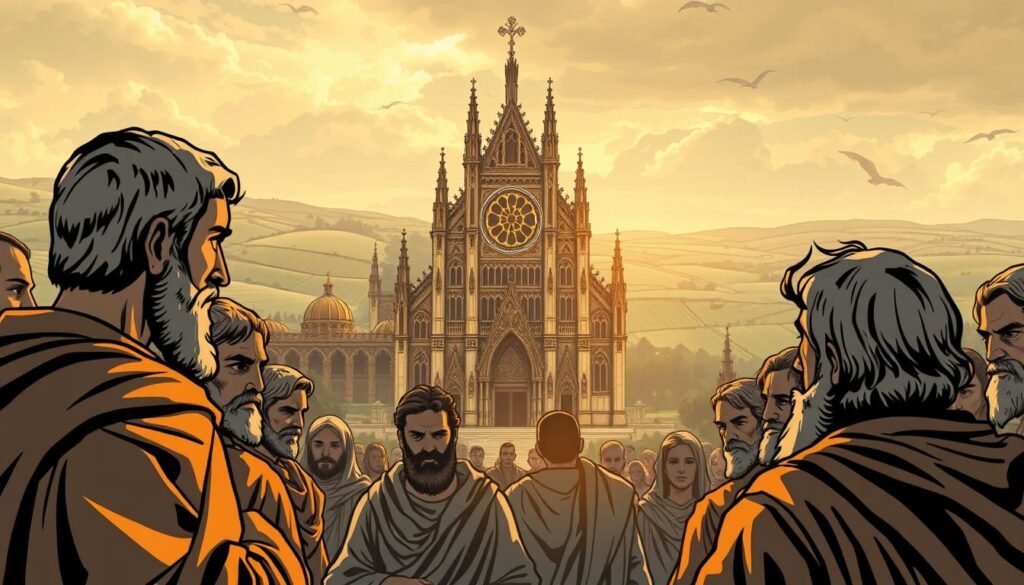
One of the most significant events in early Christianity was the Last Supper. This moment not only symbolized the establishment of the Eucharist but also laid the groundwork for the Church’s traditions. Jesus’ words, “Do this in remembrance of me,” became a cornerstone of Christian practice.
Apostolic Succession and Early Traditions
Apostolic succession refers to the passing of spiritual authority from the apostles to their successors. This process ensured the continuity of leadership and teachings. Early traditions, such as the laying on of hands, were used to appoint bishops and other leaders.
By the end of the 2nd century, bishops began gathering in regional synods to address doctrinal and administrative issues. These meetings helped unify the early Christian community and resolve disputes. The Council of Nicea in 325, for example, addressed the divinity of Christ and countered the rise of Arianism.
Formation of the Papacy
The papacy, as we know it today, evolved over centuries. The bishop of Rome, considered the successor of St. Peter, gradually gained prominence. By the 3rd century, the church in Rome functioned as a court of appeal for doctrinal matters.
The Edict of Milan in 313 legalized Christianity, reducing persecutions and allowing the faith to flourish. By 380, Christianity became the state religion of the Roman Empire through the Edict of Thessalonica. This marked a turning point in the Church’s history, solidifying its influence.
| Event | Year | Significance |
|---|---|---|
| Last Supper | 30 AD | Establishment of the Eucharist |
| Council of Nicea | 325 AD | Addressing the divinity of Christ |
| Edict of Milan | 313 AD | Legalization of Christianity |
| Edict of Thessalonica | 380 AD | Christianity as the state religion |
“The Church is built upon the foundation of the apostles and prophets, with Christ Jesus himself as the cornerstone.”
These early events shaped the Church’s leadership structures and traditions. They continue to influence its practices and teachings today, underscoring the enduring legacy of Jesus Christ and his apostles.
Influence on Philippine Culture and Society
Faith has deeply shaped the cultural and social fabric of the Philippines. From daily routines to grand celebrations, spirituality is woven into the lives of millions. This influence extends beyond personal beliefs, impacting art, education, and societal values.
Belief in God is reflected in community rituals and national events. Festivals like Simbang Gabi and Fiesta de Santo Niño bring people together, celebrating shared traditions. These events highlight the role of spirituality in fostering unity and cultural pride.
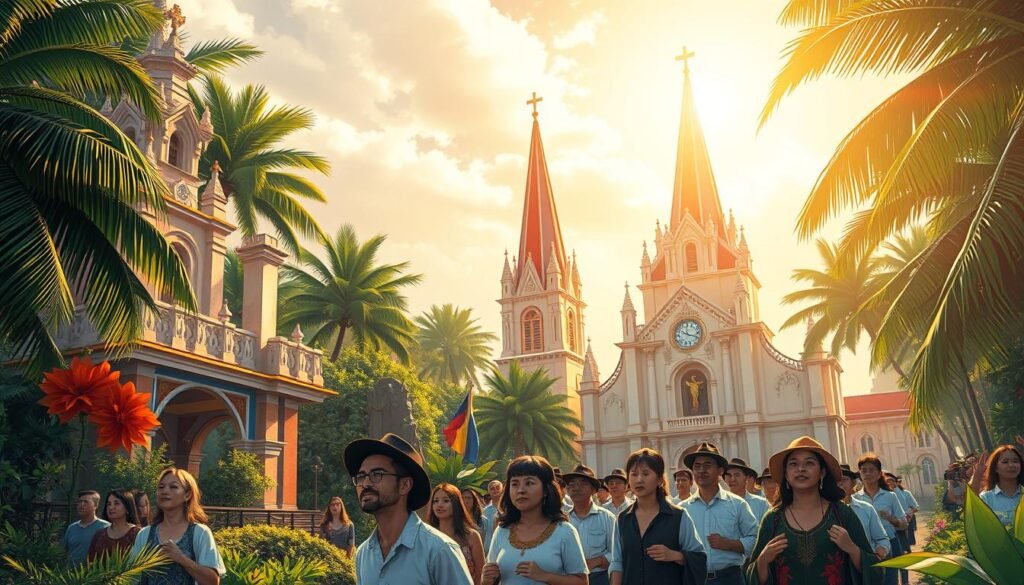
The world of Filipino art, music, and literature is also shaped by faith. Religious themes dominate traditional paintings, hymns, and stories. This artistic expression not only preserves heritage but also inspires creativity and innovation.
Education is another area where faith plays a pivotal role. Institutions like Ateneo de Manila University and De La Salle University emphasize moral and values formation. These schools nurture leaders who contribute positively to society.
Faith and spirituality have helped shape the nation’s identity and moral values. They inspire compassion, forgiveness, and a sense of community. This enduring influence continues to guide the Philippines in addressing modern challenges while preserving its rich traditions.
Spread of Christianity in the Philippines
Christianity’s journey in the Philippines began with Spanish expeditions in the 16th century. The arrival of Ferdinand Magellan in 1521 marked the start of a transformative era. His mission to introduce the faith led to the baptism of over 800 locals in Cebu, including the local chief Humabon.
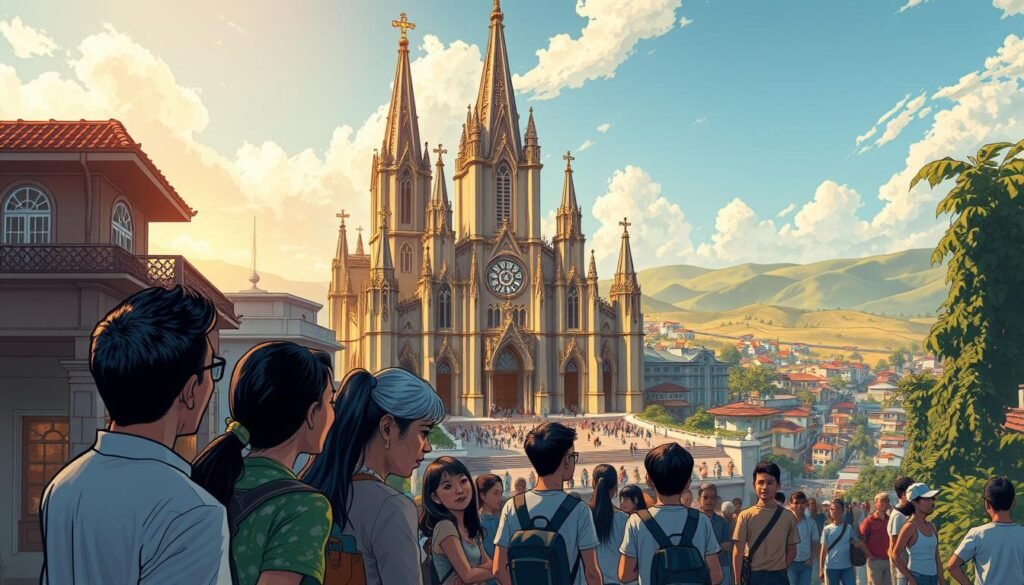
The sacrament of baptism became a central ritual in converting indigenous communities. It symbolized not only spiritual renewal but also the integration of these communities into the broader Christian world. This practice laid the foundation for the faith’s growth across the archipelago.
Missionary strategies were carefully planned and executed. Spanish friars from orders like the Augustinians, Franciscans, and Jesuits divided responsibilities for evangelization. Their efforts included teaching, building churches, and organizing communities. These actions helped establish a strong Christian presence.
The role of sacraments extended beyond rituals. They became vital tools for community building, fostering unity and shared identity. Early missionary work set the stage for the flourishing of the Filipino Christian community, which continues to thrive today.
For more insights into this historical period, explore the curious case of Emiliano Riego de.
Spanish Colonization: The Church’s Early Role
The Spanish colonization of the Philippines marked a turning point in the nation’s spiritual and cultural landscape. The Church played a pivotal role in this transformation, aligning closely with colonial efforts to establish governance and cultural reformation.
Ecclesiastical authority became deeply intertwined with state power during this period. The Vatican, as the spiritual center, influenced colonial administration, guiding policies and practices. This collaboration helped shape local governance and societal norms.
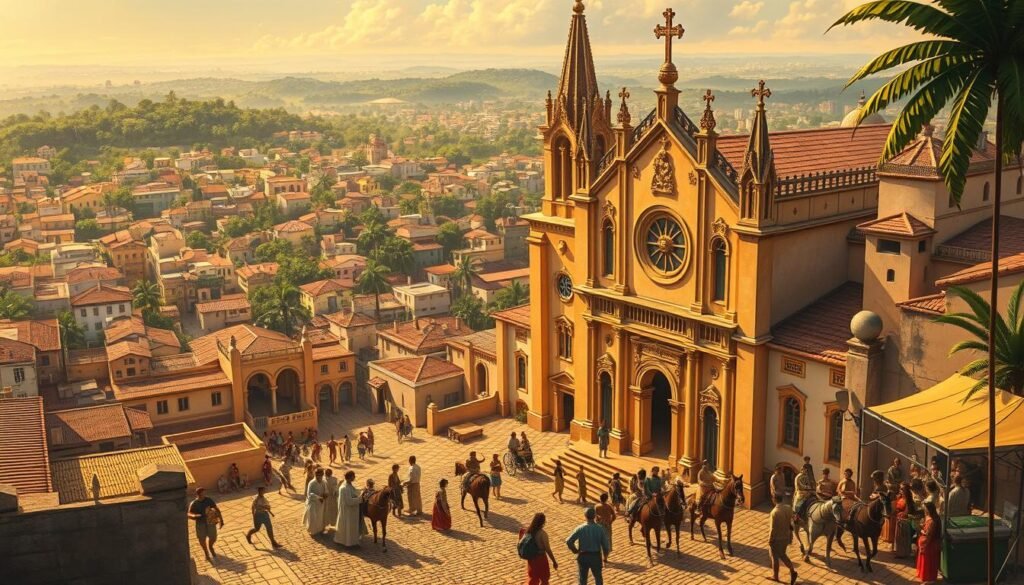
The concept of the lord was central to this era, symbolizing both spiritual and earthly authority. Church councils were instrumental in setting doctrinal standards, ensuring consistency in teachings across the archipelago. These efforts laid the foundation for a unified Christian identity.
Local practices were also reshaped by these influences. Traditional customs blended with new religious rituals, creating a unique cultural tapestry. The Church’s role extended beyond spirituality, impacting education, governance, and community life.
This period set the stage for the enduring influence of faith in the Philippines. The Church’s early role during Spanish colonization remains a defining chapter in the nation’s history, shaping its identity and values for centuries to come.
Role of Missionaries and Religious Orders
Missionaries and religious orders have been instrumental in shaping the spiritual and cultural identity of the Philippines. Their dedication and zeal transformed communities, leaving a lasting legacy that continues to inspire today.
Driven by the Holy Spirit, these missionaries brought faith to remote areas, establishing parishes and schools. Their work was not just about spreading beliefs but also about building strong, united communities. This spirit of service and compassion remains a cornerstone of their mission.
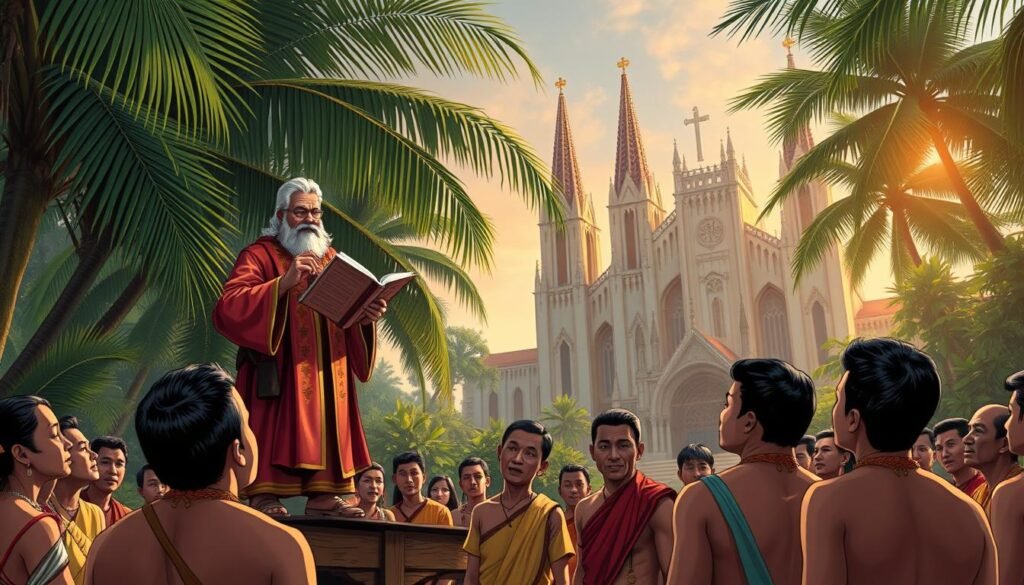
Religious orders like the Jesuits, Dominicans, and Augustinians played key roles in this effort. Each order brought unique strengths, yet they worked together as one body of faith. Their collaboration ensured that the message of unity and love reached every corner of the archipelago.
Historical examples highlight their impact. For instance, the Jesuits established educational institutions that continue to nurture leaders today. Similarly, the Augustinians built churches that stand as symbols of faith and resilience. These efforts laid the foundation for a thriving Christian community.
For more on the bravery and dedication of historical figures, explore the Visayan Joan of Arc.
The legacy of these missionaries and religious orders is a testament to their unwavering commitment. Their work not only spread faith but also fostered unity, education, and community development, shaping the Philippines into what it is today.
Organizational Structure and Governance
The governance of the institution is rooted in centuries-old traditions and structured hierarchies. Its administrative framework is guided by canonical law, ensuring consistency and order across its global operations. This legal system governs everything from leadership appointments to liturgical practices.
At the heart of this structure is the role of the father, a priestly leader who oversees spiritual and administrative duties. These leaders are part of a broader hierarchy that includes bishops, priests, and deacons. Together, they ensure the institution’s teachings and practices remain unified.
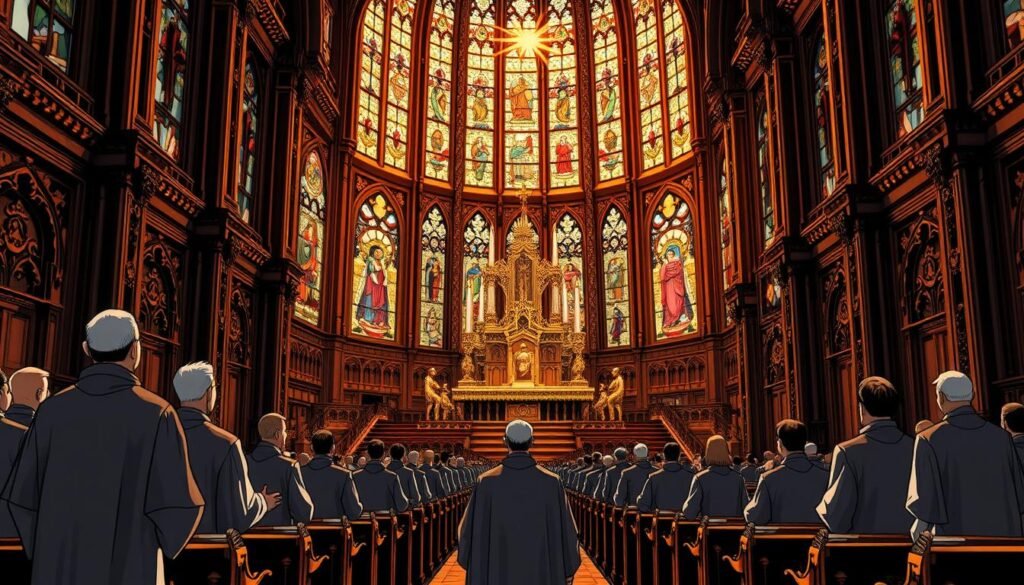
The use of Latin in liturgy and administration underscores its universal and timeless traditions. This language connects its global community, preserving its heritage while fostering a sense of unity. It also reflects the institution’s commitment to maintaining its historical roots.
Internal governance plays a vital role in maintaining doctrinal consistency. Through synods and councils, leaders address theological and administrative challenges. This collaborative approach ensures the institution remains adaptable while staying true to its core values.
For example, the Roman Curia assists in global governance, providing guidance and support to local communities. This structure enables the institution to address modern challenges while preserving its rich traditions. It is a testament to its enduring legacy and commitment to service.
Theological Doctrines and Sacraments
At the heart of faith lies the celebration of sacraments, which connect believers to divine grace. These rituals are not just symbolic acts but profound expressions of spiritual life. They serve as the foundation for community and tradition, shaping the identity of millions.
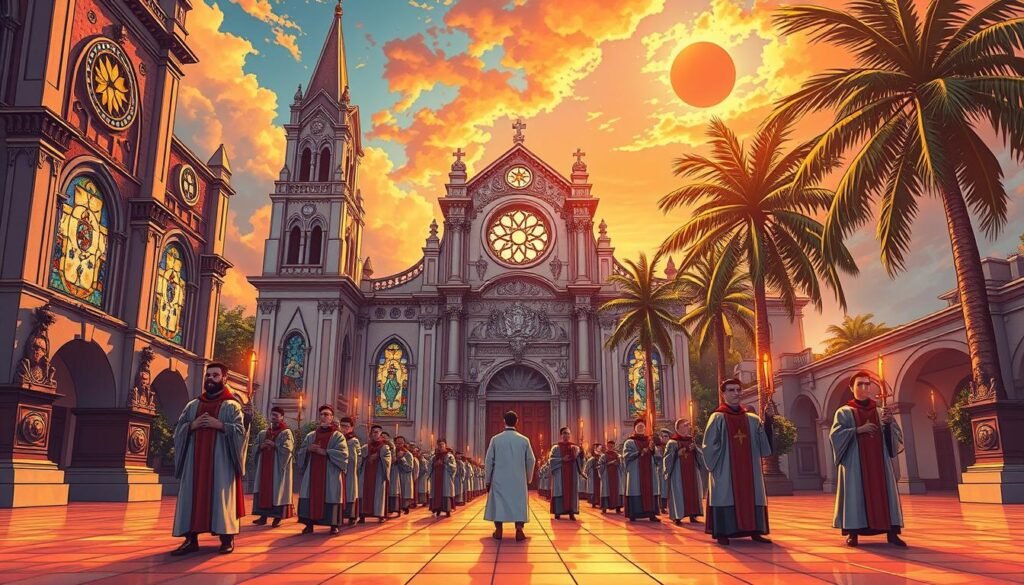
Understanding the Eucharist
The Eucharist, often called the celebration of Christ’s sacrifice, is central to worship. During Mass, believers partake in bread and wine, symbolizing the body and blood of Jesus. This act commemorates the Last Supper and reinforces the bond between the faithful and the divine.
It is considered the source and summit of spiritual life, offering nourishment and renewal. The Eucharist fosters unity, reminding believers of their shared faith and purpose.
Importance of Baptism and Confirmation
Baptism is the first sacrament, marking the beginning of a spiritual journey. It cleanses the soul of original sin and welcomes the individual into the faith community. This ritual is a foundation for all other sacraments, setting the stage for a life of grace.
Confirmation follows, strengthening the believer’s commitment to their faith. Through the laying on of hands and anointing with oil, individuals receive the gifts of the Holy Spirit. These sacraments are pivotal in nurturing spiritual growth and resilience.
| Sacrament | Significance |
|---|---|
| Eucharist | Celebration of Christ’s sacrifice, spiritual nourishment |
| Baptism | Cleansing of sin, initiation into faith |
| Confirmation | Strengthening of faith, receiving the Holy Spirit |
“The sacraments are visible signs of invisible grace, connecting us to the divine.”
These sacraments resonate deeply at the heart of belief, forming the foundation of spiritual life. They inspire unity, foster community, and guide believers in their journey of faith.
Impact on Education and Healthcare in the Philippines
Education and healthcare in the Philippines have been profoundly shaped by religious initiatives. These efforts have been a part of community development for centuries, addressing critical needs and fostering growth. From schools to hospitals, the work of religious orders has left a lasting legacy.
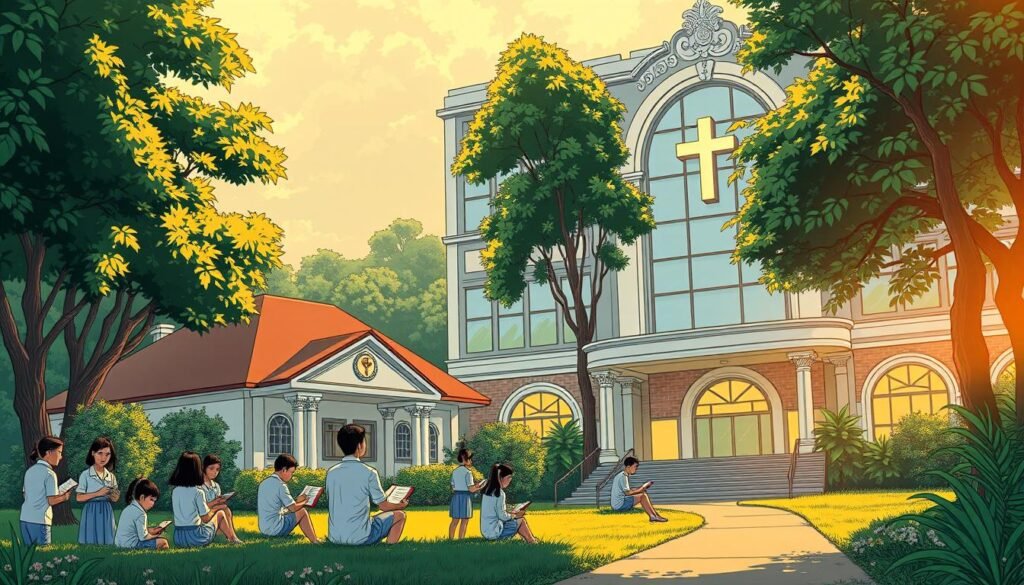
Religious groups established some of the earliest schools in the country. These institutions not only provided education but also emphasized moral and values formation. Today, over 1,500 schools are part of this network, nurturing leaders who contribute to society.
Healthcare has also benefited from these initiatives. Hospitals and clinics founded by religious orders serve millions, especially in underserved areas. Their call to care for the vulnerable has driven efforts to improve public health, including vaccination campaigns.
These initiatives have created avenues for literacy and personal growth. They have also addressed modern challenges, such as the COVID-19 pandemic, through education and community engagement. The impact of these efforts is evident in the improved quality of life for many Filipinos.
| Initiative | Impact |
|---|---|
| Educational Institutions | Promoted literacy and values formation |
| Healthcare Facilities | Improved access to medical services |
| Vaccination Campaigns | Enhanced public health during crises |
“Service to others is the rent you pay for your room here on earth.”
The work of religious groups continues to inspire and uplift communities. Their dedication to education and healthcare remains a vital part of the nation’s progress, shaping a brighter future for all.
Catholic Social Teaching and Community Service
The Second Vatican Council marked a turning point in how faith communities approach social issues. It redefined engagement, emphasizing justice, solidarity, and the dignity of every individual. These principles continue to guide community service efforts today.
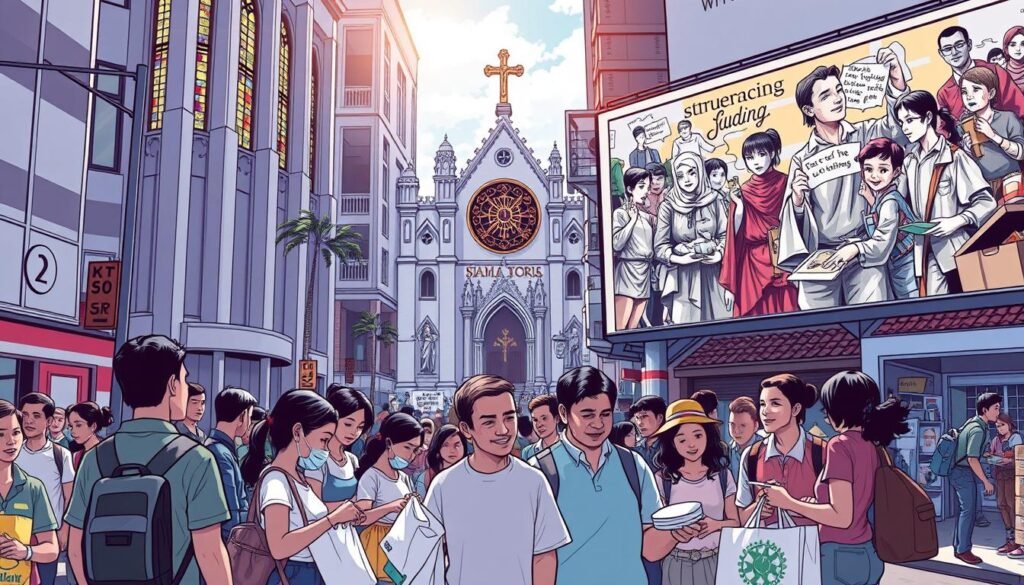
Social teachings have long addressed inequality and fostered development. Leaders, such as a bishop, play a crucial role in mobilizing efforts. Their leadership ensures that initiatives align with ethical values and the name of the organization remains synonymous with trust and accountability.
Reforms from the Second Vatican Council encouraged a shift toward active participation in societal challenges. This evolution reflects the timeless nature of these teachings while adapting to modern needs. From poverty alleviation to environmental stewardship, the focus remains on serving the common good.
Community service initiatives often highlight the importance of ethical leadership. A bishop or local leader ensures that programs are inclusive and impactful. This approach strengthens the name of the organization and fosters trust within communities.
“Solidarity is not a feeling of vague compassion but a firm and persevering determination to commit oneself to the common good.”
For more insights into these principles, explore the seven themes of Catholic Social Teaching.
These teachings have evolved to address contemporary challenges while staying rooted in tradition. They inspire individuals and communities to work toward a more just and compassionate world.
Art, Music, and Literature: The Church’s Cultural Legacy
The cultural legacy of faith has profoundly shaped artistic expression across centuries. From monumental paintings to liturgical music, the influence of spiritual traditions is undeniable. This section explores how the imagery of apostles and sacred figures has inspired countless masterpieces, leaving a lasting imprint on global culture.
The apostolic influence is vividly seen in works like Michelangelo’s Sistine Chapel ceiling. Depicting scenes from the Book of Genesis, this masterpiece reflects the deep connection between faith and artistry. Similarly, Gregorian chant, rooted in the traditions of Pope Gregory I, became a cornerstone of liturgical music, emphasizing the spiritual power of sound.
Literature also bears the mark of this legacy. Dante Alighieri’s Divine Comedy intricately weaves together theology and moral philosophy, exploring the soul’s journey through Hell, Purgatory, and Heaven. Such works not only preserve spiritual teachings but also inspire creativity and reflection.
The enduring legacy of liturgical order is evident in the architecture of chapels and cathedrals. These structures, often adorned with intricate sculptures and stained glass, serve as both places of worship and artistic marvels. They reflect the harmony between faith and beauty, inspiring awe and devotion.
- The imagery of apostles has inspired artists for centuries, from Renaissance paintings to modern interpretations.
- Apostolic traditions are reflected in liturgical music, such as Gregorian chant, which continues to resonate today.
- The order of liturgy is mirrored in the design of sacred spaces, blending spirituality with architectural brilliance.
This cultural imprint has not only shaped aesthetic traditions but also served as a medium of religious expression. It continues to inspire artists, musicians, and writers, bridging the past and present in a celebration of faith and creativity.
Challenges and Resilience through History
Throughout history, the institution has faced numerous trials, yet it has consistently demonstrated resilience and adaptability. From colonial resistance to modern controversies, it has navigated complex social and cultural landscapes, emerging stronger each time.
Colonial Resistance and Adaptation
During the colonial era, tensions arose between indigenous traditions and imposed practices. The institution faced resistance but eventually adapted, blending local customs with its teachings. This period tested its ability to evolve while preserving its core mission.
The vatican council played a crucial role in guiding these adaptations. Its decisions helped the institution navigate the challenges of colonial rule, ensuring its relevance in a changing world. Over time, it became a symbol of unity and hope for many Filipinos.
Contemporary Controversies
In modern time, the institution has faced debates over doctrinal and social issues. Its word has been central to these discussions, often sparking both support and criticism. These controversies highlight the ongoing struggle to balance tradition with contemporary values.
Despite these challenges, the institution has remained steadfast. Its ability to adapt while staying true to its mission has been a testament to its resilience. As it continues to address modern issues, its word remains a guiding light for millions.
| Period | Challenge | Response |
|---|---|---|
| Colonial Era | Resistance to imposed practices | Adaptation and integration of local customs |
| Modern Times | Doctrinal and social debates | Guidance through the vatican council |
“Resilience is not just about enduring challenges but also about finding ways to grow and thrive amidst them.”
For more insights into how faith provides support during challenging times, explore faith in hard times.
Modern Reforms and the Second Vatican Council
The Second Vatican Council marked a transformative era in the faith community, reshaping traditions and practices. Held from 1962 to 1965, it introduced sweeping reforms that modernized liturgy and fostered cultural renewal. This council redefined the way believers engaged with their faith, emphasizing inclusivity and active participation.
Cultural Shift and Renewal
One of the most significant outcomes of the Second Vatican Council was the shift toward a more inclusive and participatory approach. The liturgy was translated into vernacular languages, making it accessible to a broader audience. This change allowed believers to connect more deeply with their faith, fostering a sense of unity and belonging.
The role of the minister also evolved during this period. Ministers became facilitators of spiritual growth, guiding communities through the changes brought by the council. Their leadership was crucial in helping believers adapt to the new way of worship and community engagement.
The council also encouraged dialogue with other religions, promoting mutual understanding and respect. This openness marked a significant departure from previous practices, reflecting the council’s commitment to addressing contemporary challenges. For more insights into these reforms, explore the Second Vatican Council.
“The Church is called to serve humanity, not to dominate it. This is the essence of the reforms initiated by the Second Vatican Council.”
These changes have allowed the faith community to remain responsive to modern challenges while preserving its core values. The Second Vatican Council remains a testament to the enduring adaptability and resilience of spiritual traditions.
Church-State Relations in the Philippine Context
The relationship between spiritual and political authority in the Philippines has long been a topic of debate and influence. The pope, as a global spiritual leader, has often played a significant role in shaping public opinion and policy. This contrasts with the secular governance that seeks to maintain a balance between religious and state affairs.
The concept of profession of faith has frequently entered political debates. For instance, during the discussions on the Reproductive Health Law, the pope’s stance influenced many lawmakers and citizens. This highlights how deeply intertwined faith and governance can be in the Philippines.
Individual personhood and community identity are also shaped by these dynamics. Religious teachings often guide personal values, which in turn influence societal norms. This dual influence is evident in events like the People Power movements, where spiritual leaders played pivotal roles in mobilizing the masses.
Historically, the separation of church and state was a contentious issue. The 1987 Constitution explicitly states this separation, yet the pope’s moral authority continues to resonate in political decisions. Modern examples, such as the Church’s involvement in social justice campaigns, show how this relationship evolves while remaining impactful.
“The separation of Church and State shall be inviolable, yet the moral voice of faith remains a guiding force in our nation.”
For more insights into current issues affecting these relations, explore this statement by the Catholic Bishops Conference of the Philippines.
Global Outreach: International Influence and Diaspora
Diaspora communities have played a pivotal role in spreading spiritual traditions worldwide. From the Philippines to distant corners of the earth, these groups have carried their faith, fostering unity and resilience. Their efforts highlight the enduring power of shared beliefs in shaping communities.
The theme of communion underscores the bond among believers, regardless of geography. This shared connection has inspired missionary work, bridging cultures and generations. It reflects the universal message of hope and compassion that transcends borders.
Christ, as the son of God, remains a symbol of salvation and renewal for millions. His teachings have guided individuals and communities, offering strength in times of challenge. This spiritual foundation continues to inspire global outreach and unity.
For more on how independent communities are shaping the future of faith, explore this insightful article.
“The global family of faith is united by a shared commitment to love, justice, and hope.”
Through missionary endeavors and diaspora networks, the message of faith has reached every corner of the world. This global outreach not only strengthens communities but also fosters a deeper understanding of our shared humanity.
Catholic Church in Philippine Society
In the Philippines, spirituality remains deeply intertwined with daily life, shaping traditions and community bonds. The Church continues to be a vibrant force, influencing both cultural practices and societal values. Its presence is felt in everything from festivals to family gatherings, reflecting its enduring relevance.
Holy traditions, such as Simbang Gabi and Fiesta de Santo Niño, are central to Filipino culture. These events bring communities together, celebrating shared heritage and faith. They serve as reminders of the Church’s role in fostering unity and cultural pride.
Collective prayer is another cornerstone of Filipino life. From daily devotions to Sunday Mass, it strengthens communal bonds and provides spiritual guidance. This practice underscores the Church’s ability to inspire and uplift individuals, even in modern times.
Ancient liturgical rites continue to shape worship and public ceremonies. These rituals, passed down through generations, connect Filipinos to their spiritual roots. They highlight the Church’s ability to adapt while preserving its rich traditions.
For more on the evolving role of faith in society, explore this insightful article.
“Faith is not just a belief; it is a way of life that unites and inspires.”
The Church’s influence extends beyond spirituality, shaping education, healthcare, and social justice initiatives. Its teachings continue to guide Filipinos in addressing modern challenges while staying true to their heritage. This dual role ensures its relevance in both spiritual and cultural spheres.
Conclusion
For centuries, the Philippines has been shaped by a profound spiritual legacy that continues to inspire hope and unity. From its historical roots to modern reforms, this institution has played a pivotal role in fostering culture, education, and social justice.
Its teachings have guided communities through challenges, offering a vision of heaven as the ultimate aspiration. This enduring influence reminds us of the power of faith to unite and uplift, even in times of uncertainty.
As we reflect on its journey, we are encouraged to embrace its values of compassion and service. The Church’s role as a beacon of hope remains vital, inspiring Filipinos to build a brighter future together. For more on its impact, explore this resource.
FAQ
What is the significance of apostolic succession in the Catholic Church?
Apostolic succession ensures the continuity of leadership and teachings from the original apostles to modern-day bishops, preserving the faith’s authenticity and unity.
How did the papacy develop in the early Church?
The papacy evolved as the Bishop of Rome gained prominence, becoming the central authority and spiritual leader for Christians worldwide.
What role did missionaries play in spreading Christianity in the Philippines?
Missionaries introduced the faith, established communities, and integrated Christian values into local culture, shaping the nation’s spiritual identity.
Why are the Eucharist, Baptism, and Confirmation central to Catholic doctrine?
These sacraments mark key moments in a believer’s spiritual journey, symbolizing grace, initiation, and commitment to the faith.
How has the Catholic Church influenced Philippine education and healthcare?
The Church founded schools, universities, and hospitals, providing accessible education and medical care while promoting moral and ethical values.
What is the Second Vatican Council, and how did it impact the Church?
The Second Vatican Council modernized practices, encouraged lay participation, and fostered dialogue with other religions, revitalizing the faith globally.
How does the Catholic Church address social issues in the Philippines?
Through Catholic Social Teaching, the Church advocates for justice, human dignity, and community service, addressing poverty, inequality, and other challenges.
What is the Church’s cultural legacy in the Philippines?
The Church enriched Philippine art, music, and literature, blending local traditions with Christian themes to create a unique cultural heritage.
How does the Church navigate its relationship with the Philippine government?
The Church maintains a collaborative yet critical stance, influencing policies while advocating for moral governance and social justice.
What is the global impact of the Catholic Church’s outreach?
The Church supports international missions, aids global communities, and unites the Filipino diaspora, fostering faith and solidarity worldwide.
Source Links
- No title found
- Catholic Church in the Philippines
- The Catholic Church in the Philippines
- Roman Catholicism | Definition, Religion, Beliefs, History, & Facts | Britannica
- History of the Catholic Church
- The Catholic Church’s Influence on Filipino Society and Politics – Pinas Culture
- Filipino – Religion
- Christianity in the Philippines
- Christian History of the Philippines Drive Thru History :Ends of the Earth
- Philippines – Spanish Colonization, Culture, Trade | Britannica
- Catholicism in the Philippines during the Spanish Colonial Period 1521-1898 | 4 Corners of the World
- Catholicism in the Philippines: A Legacy of Spanish Colonization – Pinas Culture
- Catholic missions
- Religious Orders as Transnational Networks of the Catholic Church — EGO
- Hierarchy of the Catholic Church
- The Hierarchical Structure of the Church | EWTN
- Who governs the Catholic Church? It’s an open question.
- Roman Catholicism – Dogmas, Doctrines, Beliefs | Britannica
- Catholic theology
- Educational Challenges in the Philippines
- In the service of the Filipino: the role of Catholic higher education institutions in promoting COVID-19 vaccines in the Philippines
- Call to Family, Community, and Participation
- Catholic Social Teaching | Justice and Peace Office
- Principles of Catholic Social Teaching – Seton Hall University
- The Impact of Catholicism on the Arts – Catholicism
- What Happened to the Catholic Church’s Art Patronage
- Resilience in Pontifical Doctrines: From Pope Benedict XVI to Pope Francis
- Leadership Lessons from 2000 Years of the Catholic Church | IE Insights
- A ‘theology of resilience’ in the Philippines
- An overview of the Second Vatican Council – Vatican News
- Second Vatican Council
- Roman Catholicism – Ecumenism, Liturgy, Doctrine | Britannica
- Church-State Separation and Challenging Issues Concerning Religion
- Church-State Relations in the 1899 Malolos Constitution: Filipinization and Visions of National Community
- A Catholic guide to migration ethics in the Trump era
- Popes as Public Diplomats: A Longitudinal Analysis of the Vatican’s Foreign Engagement and Storytelling
- The beginning of Catholicism in the Philippines
- Philippines, The Catholic Church in
- Is Catholicism Failing in the Philippines? – Catholic Stand
- Science and the Catholic Church
- The Role of the Catholic Church against Changes and Threats to the Value of Work

